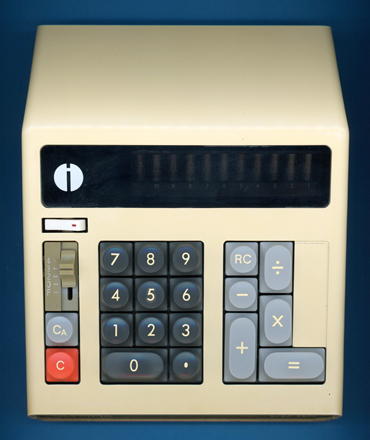
DATAMATH CALCULATOR MUSEUM
 |
DATAMATH CALCULATOR MUSEUM |
Olympia CD101
| Date of introduction: | 1973 | Display technology: | VFD |
| New price: | Display size: | 10 | |
| Size: | 7.8" x 6.9" x
2.2" 198 x 173 x 57 mm3 |
||
| Weight: | 34.4 ounces, 977 grams | Serial No: | 0812699 |
| Batteries: | 4*C | Date of manufacture: | mth 08 year 1973 |
| AC-Adapter: | 220 V | Origin of manufacture: | Japan |
| Precision: | 10 | Integrated circuits: | TMS0121 |
| Memories: | Displays: | 1*Futaba SP8D2, 8*Futaba DG8R | |
| Program steps: | Courtesy of: | Joerg Woerner |

![]()
 Olympia Werke
was founded in 1903 in Germany to develop and manufacture typewriters - please
remember the famous "Mignon". Early in the Seventies Olympia partnered with
Matsushita Electric Industrial Co., better known under their brands
Panasonic
Corporation or National, to stay competitive on the difficult market of
electronic calculators before operations were ceased in 1991.
Olympia Werke
was founded in 1903 in Germany to develop and manufacture typewriters - please
remember the famous "Mignon". Early in the Seventies Olympia partnered with
Matsushita Electric Industrial Co., better known under their brands
Panasonic
Corporation or National, to stay competitive on the difficult market of
electronic calculators before operations were ceased in 1991.
Matsushita introduced already in 1969 with the PANAC-12W (JE-240) their first electronic desktop calculator with 12-digit capability and Nixie tube display joining established Japanese manufacturers like Busicom, Canon, Sanyo, Sharp, Sony and Toshiba. Next important step in Matsushita's calculator line was the sleek Panasonic 1000 (JE-102) introduced in 1971 and based on seven LSI (Large Scale Integration) chips manufactured by Mitsubishi before introducing in 1972 the Panasonic 1010 (JE-1010) with just two Mitsubishi LSI chips and finally switching with the JE-801 and JE-1001 to Texas Instruments' single-chip calculator technology.
While many customers opted for Standard Products of the TMS0100 Family like the TMS0101 used with the Canon LE-80, the TMS0103 found in the Bowmar 901B or TMS0106 designed into the Radio Shack EC-2000, made Matsushita use of the flexible design concept of the TMS0100 architecture and as of today we know six Customized TMS0100 chips exclusively used with Panasonic or Olympia calculators:
| Type | Panasonic Calculators | Olympia Calculators | Digits | Rounding | Special Functions | Comments |
| TMS0115 | Panasonic JE-850 | Olympia CD80 | 8 | NONE | Fancy Four | |
| TMS0121 | Panasonic JE-1001 | Olympia CD101 | 10 | DOWN, 5/4 | [X<>Y] | Fancy Four |
| TMS0122 | Panasonic JE-850 | Olympia CD80 | 8 | NONE | Identical to TMS0115 | |
| TMS0130 | Panasonic JE-860 | Olympia CD85 | 8 | t.b.d. | Memory | Fancy Four |
| TMS0131 | Panasonic JE-855 | Olympia CD81 | 8 | t.b.d. | [√x][pi] | Fancy Four |
| TMS0139 | Olympia CD101A | 8 | t.b.d. | [X<>Y], % | Fancy Four |

 Dismantling the featured Olympia CD101 Desktop Calculator
manufactured in August 1973 by Matsushita in Japan reveals a compact design
centered around the TMS0121 single-chip calculator circuit surrounded by many
discrete components to drive the 11-digit Vacuum Fluorescent Display (VFD)
assembled with individual tubes and powered by either 4 C-sized Alkaline
batteries or a 220 Volts outlet.
Dismantling the featured Olympia CD101 Desktop Calculator
manufactured in August 1973 by Matsushita in Japan reveals a compact design
centered around the TMS0121 single-chip calculator circuit surrounded by many
discrete components to drive the 11-digit Vacuum Fluorescent Display (VFD)
assembled with individual tubes and powered by either 4 C-sized Alkaline
batteries or a 220 Volts outlet.

 Knowing the exceptional
build quality of Matsushita's early calculators like the JE-850, this Olympia
CD101 doesn't disappoint. The connector to the long-travel keyboard assembly is
gold-plated, the VFD tubes are placed in a solid mounting frame and the power
supply has enough headroom and does not even warm up during calculator
operation.
Knowing the exceptional
build quality of Matsushita's early calculators like the JE-850, this Olympia
CD101 doesn't disappoint. The connector to the long-travel keyboard assembly is
gold-plated, the VFD tubes are placed in a solid mounting frame and the power
supply has enough headroom and does not even warm up during calculator
operation.


 Preparing our DCM-50A Platform
to allow the Characterization of Single-Chip Calculator Circuits
of the TMS0100 Family, we studied the
featured Olympia CD101 calculator manufactured in August 1973. In a first step we
observed with a Mixed Signal Oscilloscope (MSO) the signals at the TMS0121 Chip
to verify its pin-out before disassembling the calculator completely to analyze
its printed circuit board (PCB) wiring.
Preparing our DCM-50A Platform
to allow the Characterization of Single-Chip Calculator Circuits
of the TMS0100 Family, we studied the
featured Olympia CD101 calculator manufactured in August 1973. In a first step we
observed with a Mixed Signal Oscilloscope (MSO) the signals at the TMS0121 Chip
to verify its pin-out before disassembling the calculator completely to analyze
its printed circuit board (PCB) wiring.

![]() Confirming the
pin-out of the calculator chip and reverse-engineering the keyboard matrix, we
were able to fully operate the TMS0121 in our DCM-50A Platform and measure
precisely the timing of its Display and Keyboard interface.
Confirming the
pin-out of the calculator chip and reverse-engineering the keyboard matrix, we
were able to fully operate the TMS0121 in our DCM-50A Platform and measure
precisely the timing of its Display and Keyboard interface.
If you have additions to the above article please email: joerg@datamath.org.
© Joerg Woerner, April 14, 2024. No reprints without written permission.